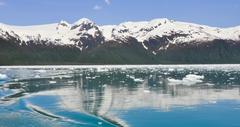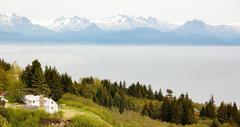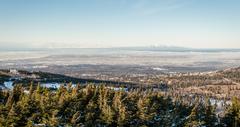Lake Clark National Park and Preserve is a backcountry park on the Alaskan peninsula. There is no road access to the park and preserve; most visitors arrive by small plane. Varying terrain at the park includes the junction of three mountain ranges, two volcanoes, rainforests, tundra, glacial lakes and rivers. Many of the park’s streams and lakes are vital to the Bristol Bay salmon fishery. The only maintained hiking trail system within the park is the Tanalian Trails system.
The trailhead is adjacent to the southernmost airstrip in Port Alsworth, deep within the heart of the park. Hikes range from moderate to rigorous. The Beaver Pond trail offers a moderate hike through birch groves and around a beaver pond; the hike offers excellent summer bird-watching. A more difficult hike takes visitors through spruce covered hillsides for a view of Lake Clark.
At the top, the 30-foot Tanalian Falls are a waterfall of glacier waters over hardened ancient lava. Hikers who continue further into the backcountry will reach Kontrashibuna Lake. Tanalian Mountain offers difficult uphill hiking for a stunning panoramic view of Lake Clark. One of the more popular backcountry hikes to Teetering Rock begins at the cabin of Richard Proenneke, a famous wilderness enthusiast who lived in the cabin on the shore of Upper Twin Lake for thirty years. The hand built log cabin from 1967 has been on the National Register of Historic Places since 2007. The park’s Twin Lakes are popular for sport fishing for sockeye salmon and arctic grayling, among other species. Visitors also enjoy kayaking and canoeing, or paddling to the outlet of the Lower Twin Lake for white water rafting down the Chilikadrotna River. Guests who prefer not to camp can spend the night at rustic cabins at Priest Rock. The cabins are located on Lake Clark approximately 8 miles from Port Alsworth, and were originally built by Allen Woodward, a summer resident of Lake Clark from 1950 through the early 2000’s. A museum at the park manages a collection of over 200,000 herbs, fossils, journals, photographs and objects, many of which belonged to the late Richard Proenneke.
Also at the museum is a double-ender Bristol Bay wooden sailboat belonging to Allen Woodward and once used in Alaskan commercial fishing in the mid-1900’s. The sailboat was donated to the park by the Woodwards in 2000. The museum is located at the Visitor Center in Port Alsworth.
History: The original name of Lake Clark is “Qizhjeh Vena,” or ‘place where people gather.’ This name reflects the region’s role in supporting the Dena’ina people who have lived there for thousands of years, and continue to live off the land today. In 1962, the American Richard “Dick” Proenneke was invited by friends to Upper Twin Lake. He loved it so much he returned year after year and in 1967, at the age of 51, was ready to scout out a site for his own cabin. When a location was found, he began to harvest spruce trees to build the cabin that was to be his home for the next 30 years. Dick was a master craftsman and built his home with local tools and materials. His simple lifestyle made room for an awareness of the wilderness, and he kept meticulous notes, journals and films during his time at Upper Twin Lake.
He recorded wildlife, weather, and the humans who visited him. He was not a hermit, and maintained correspondence with anyone who wrote him a letter. His life inspired the 1977 short film “One Man’s Alaska” and his journals have been published into books. Proenneke was a conservationist who aimed to live with the least impact possible on the wilderness around him.
He matured from a sport hunter to a subsistence hunter, to a non-hunter during his time in the Twin Lakes region. His off-the-grid life resonates with many around the world and his wilderness ethos has been an inspiration. Proenneke, and fellow local Allen Woodward were among a group of World War II veterans whose skills as pilots allowed them to explore the Alaskan territory when it opened up after the war. Allan Woodward sold the first of his three cabins to the National Park Foundation in 1979, one year before the site became a National Park in 1980.
Ongoing Programs and Education: In the summer month, park rangers are stationed at Richard Proenneke’s cabin and offer tours to any guests who arrive. No reservations are needed. The site of the hand built log cabin includes a raised cache for the storage of food and a woodshed with an outhouse.
Port Alsworth, AK 99653, Phone: 907-781-2118





